War Stories 18
Enjoy the stories in this section. Some of them may even have been true!! Have a favorite war story you've been relating over the years? Well sit down
and shoot us a draft of it. Don't worry, we'll do our best to correct grammar, punctuation, and spelling before we publish it. to us and we'll publish them for all to enjoy.
Memories Undimmed by Time: FSB David- Cambodia -14 June 1970
By Joel Chase and Terry McCarl
INTRODUCTION
By Terry A. McCarl, Historian, 15th Medical Battalion Association
As the Historian of the 15th Medical Battalion (BN) Association, I am
privileged to research, read, and write about the heroic and meritorious
acts of members of the 15th Medical Battalion. Such stories are abundant,
particularly Medevac helicopter rescue missions plus life-saving emergency
medical care at the 15th Med BN medical treatment facilities. The following
is a story about such a mission, but it is about much more than that. It is
a story of extreme courage, fortitude, endurance, and resourcefulness about
a young Army officer and his unit that found themselves in what must have
seemed like a hopeless situation.
I first met CPT Joel Chase and his wife, Dorothy, at the 15th Med BN
Association Reunion in Branson. MO, April 26-30, 2017. At one of the evening
informal get-togethers in the Hospitality Room, Joel asked if he could
address the group. Joel explained that he had been a Platoon Leader of D
Co., 1/5 Cav located at FSB David, about 10 miles inside the Cambodian
border. At 0300 on 14 June 1970, with a terrain challenging to defend and
out of range of supporting artillery, FSB David was attacked.
The
story, briefly, was that Joel was seriously wounded and taken to the B Co.
15th Medical Battalion medical treatment facility at FSB Buttons near Song
Be. He was unconscious during the period he was being transported to
FSB Buttons.
After he received emergency medical treatment at Buttons, a
Medevac helicopter flew him to the 24th Evacuation Hospital in Long Bien. He
was then transported to Japan and then home to the US. Miraculously, he
survived and was there in Branson, MO 47 years later, in 2017 to relate his
story.
That night Joel and his wife Dorothy expressed their
appreciation to the 15th Medical Battalion for saving his life. Their
presentation was very moving.
Three individuals who were involved in
Joel's medical treatment at the B Co. facility were at the reunion: 1LT Tom
Garnella, CPT Jon Lundquist, and SP5 Richard Schroder - more about them
later. Joel asked if anyone present at the gathering was with the Medevac
crew that hauled him from FSB David to FSB Buttons, but there was no
response.
I talked to Joel the next day, and he said that if
possible, he would like to get in contact with and personally thank the
Medevac pilots and crew members who rescued him from LZ David. I advised
Joel I would poll our membership to identify and locate these individuals.
I posted an inquiry on the 15th Medical BN Facebook page asking if
anyone knew who was on that crew. Dan Brady, medic, contacted me. He
said that it was the mission during his time in Vietnam that he remembers
the most vividly. We proceeded from there to identify the other crew members.
Joel's Vietnam tour began on 04 October 1969. In April of 1970, Joel had
completed six months of his VN tour and was eligible for transfer out of the
field to a relatively “safer” job. He chose instead to stay with his unit as
Platoon Leader. Then, in May of 1970, the Cambodian Incursion came about!
Here is Joel's story in his own words.
JOEL CHASE'S STORY
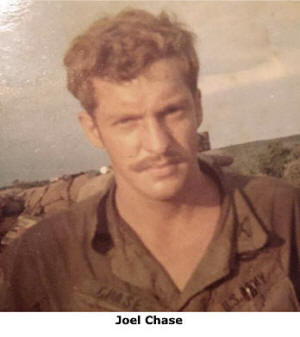 I was a platoon leader with the 1st Air Cav in 1969 and 1970
following graduation from OCS at Benning. When I got to Vietnam, I realized
OCS had not prepared me to be an infantry platoon leader, but I had
out-standing and understanding Non-Commissioned Officer Sergeants. It took
them a while to educate me, but I finally “got it” after about six months in
the brush. Then “Tricky Dick” gave us the green light to go kick some butt
in Cambodia, so the decision to stay with my platoon was an easy one.
I was a platoon leader with the 1st Air Cav in 1969 and 1970
following graduation from OCS at Benning. When I got to Vietnam, I realized
OCS had not prepared me to be an infantry platoon leader, but I had
out-standing and understanding Non-Commissioned Officer Sergeants. It took
them a while to educate me, but I finally “got it” after about six months in
the brush. Then “Tricky Dick” gave us the green light to go kick some butt
in Cambodia, so the decision to stay with my platoon was an easy one.
We were in the draw-down mode and weren't getting replacements for those
going home or wounded. At last count, my platoon was down to 17 guys,
including some short-timers and a couple of FNGs, and the bad guys in
Cambodia were formidable adversaries. They were well-armed, trained, fed,
and didn't run from a fight.
Battalion (1st of the 5th Cav) finally
took pity on our little company (D) and put us on the green line at Fire
Support Base (FSB) David, a tiny place 10 miles inside the border and
outside of artillery fan fire from other FSB's. The Cav had done severe
damage to the NVA caches and other infrastructure, which mightily pissed
them off. So they launched an all-out attack on David on 14 June 1970 at
0300. What their commanders didn't understand was that we were waiting for
them.
The first shot fired on David was from an M16 at about 0300. A
trip flare in my sector went off, and a guard on a bunker thought he saw
movement and fired one round at that spot. After visually scanning the area
for nearly 30 minutes without locating any enemy, we were about to give up
when a guy next to me thought he saw something and pointed to it just inside
the concertina wire. It was indeed an NVA sapper, and when discovered, he
cranked off several rounds from his AK rifle right at me. However, he aimed
too low, and the bullets skimmed off the berm and grazed the top of my head.
Suddenly all hell broke loose as M-16's, AK-47's, and M-60's rattled
away for almost three hours along with mortars, 105's, and B-40 rockets.
(Note: The fog was too thick for air support, so we were reliant on our
organic mortars and 105's.)
While I was on the radio to my CO, a
chi-com grenade rolled up next to me and detonated. It was thrown by an NVA
that had infiltrated our perimeter and was lying just outside the berm, but
we never saw him. I have to admit he was a pretty cool customer and good at
camouflage. I'm sure he paid the ultimate price for his actions, however,
along with 27 other of his comrades.
My injuries from the grenade
were severe, and it was three hours before receiving any medical attention
as the battle raged, which I missed due to loss of conscience, loss of
blood, and shock. From a technical standpoint, I should have died.
The after-action report, daily log, and manning report listed 28 NVA KIA
(Killed In Action) with numerous blood and drag trails the next morning,
suggesting they probably had more losses than 28. It was a miracle that not
a single GI died in the battle. It is sometimes better to be lucky than
good!
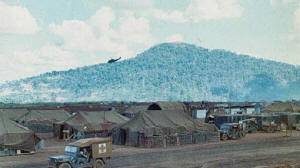 Soldiers told me I was unconscious at about 0600 when the fog began to
dissipate and the sun rose to allow a Medevac helicopter to land and take me
plus eight others of the most seriously wounded to FSB Buttons. Shortly
after that, a Chinook (CH-47 helicopter) landed with an emergency resupply
of ammunition, unloaded, and loaded the remaining 24 wounded and took them
to FSB Buttons.
Soldiers told me I was unconscious at about 0600 when the fog began to
dissipate and the sun rose to allow a Medevac helicopter to land and take me
plus eight others of the most seriously wounded to FSB Buttons. Shortly
after that, a Chinook (CH-47 helicopter) landed with an emergency resupply
of ammunition, unloaded, and loaded the remaining 24 wounded and took them
to FSB Buttons.
I do remember the cold air of the aircraft waking me
up for a moment and asking where I was when I arrived at FSB Buttons aid
station. I woke up to Tom Garnella's voice and getting bumped down some
steps into a cave. Somebody said: “Be careful; he has a broken arm.”
However, I don't remember much of that, which is probably for the best.
I wasn't hurt badly by the AK rounds but was bleeding pretty good. When
the grenade went off, all I heard was a pop, and then it felt like somebody
took a baseball bat to my entire body. I was blinded and deaf but knew I was
in sad shape and attempted to crawl - somewhere. I had a pulverized right
elbow that collapsed, so I kind of snaked my way to a pile of sandbags to do
a little BDA, Body Damage Assessment. My sight started to return, and I
realized I had crawled into one of our scout tents.
As the evening wore on, the tent that I was in looked like Swiss cheese
when illumination was up. I kept getting hit by either B-40 or mortar
shrapnel as I lapsed in and out of conscientiousness. The burning shrapnel
hitting me jolted me awake and probably saved my life. I was evacuated to FSB Buttons and then to
the 24th Evac. They split me open like a trophy deer to fix the damage done
to my liver, kidney, spleen, and other internal stuff. Then they discovered
that I had a piece of shrapnel in the right brachial artery that had been
sent there by my heart. There were two more chunks in the heart they left
alone and are still there to this day unless they rusted away.
After
the flight to Japan, I nearly “bought it.” My heart was still leaking, but
the sac around it had begun to heal, so I had near-fatal pressure building
up, requiring tapping three times before the bleeding stopped.
My
poor parents were subjected to telegrams from the Army, listing all my
injuries in gory detail. A telegram dated 1 July 1970 stated, ”He received
wounds to the back, scalp, abdomen (with hemothorax, lacerations of the
liver and right renal), chest with right hemopneumothorax, and embolus of
the right brachial artery and all extremities. And both eyes had partial
loss of vision to the left eye and corneal abrasions to both eyes.”
Another telegram dated 08 July 1970 stated, “Your son was placed on the very
seriously ill list. He has an additional diagnosis of a wound to the heart,
right lung, right lobe of the liver, right arm, and a fracture to the right
olecranon. In the attending physician, his condition is of such severity
that there is cause for concern. His present condition and prognosis are
noted to be fair and his morale good.”
My ten months in the “brush”
weren't without some excitement. They resulted in awards of the Silver Star,
Bronze Star with V device for Valor and Oak Leaf Cluster, Purple Heart (PH)
with Oak Leaf Cluster, Air Medal, and Army Commendation Medal with V device
plus all the “I was there” stuff. I wanted to make the Army a career, but
they said they no longer required my services and retired me at 100%
disability at the rank of Captain. Anyway, it was an interesting ride while
it lasted.
I got a 100% disability for my trouble and then went into
sales as a manufacturer's rep. My left eye has since lost all sight but have
no regrets and would do it all again. About seven years ago, I decided I was
deserving of a second PH and began the process of begging the Army to grant
my request. I ran into objections like you need two sworn witnesses (which I
didn't have), two MD attendants who treated me (which I didn't have), and
then they told me only one PH per deployment was authorized each individual.
It went on and on with six-month intervals between their responses. They
were jerking my chain, and it took me five years, but I finally got it after
a Congressional Inquiry and a two-star intervention. The low-quarter
personnel LTC who continually trashed my requests got a reprimand much to my
enjoyment.
THE MEDEVAC CREW
Historian's Note: I was delighted to hear from
Dan Brady, who responded to my Facebook post that he was the medic on that
Medevac mission on 14 June 1970. He said, “I'm sure that Jon Hodges was Crew
Chief and Mike Parsons was Gunner that night. I know Oakie (1LT Hank Tuell)
was the Aircraft Commander, and Mr. Trifiro or Mr. Simpson was the Copilot.
I do remember lots of dead outside the wire when we finally got in. Don't
remember how many tries it took. I do remember my one patient, though. Bad
head wounds and face a mess. I had to do CPR on him. I'm sure he was an SGT
or higher or an officer. I didn't find out if he made it or not. Though I'm
getting foggy about many of my missions, that one remained clear in my
mind!”
Hank Tuell confirmed Dan's recollections. Tom Trifiro was
contacted and responded that he could not remember the mission. Greg Simpson
said he was not 100% certain, but quite sure he was the Copilot on that
mission.
Mike Parsons, the Gunner, is reported to have taken his own
life about 30 years after his Vietnam service. No other details are
available at this time.
Dan Brady and several others report trying to
find Jon Hodges, the Crew Chief, but attempts have been unsuccessful, Jon,
if you are reading this, please contact me at
historian@15thmedbnassociation.org .
CPT JON WALKER'S STORY
Historian's Note: CPT Jon G. Walker was the 1/5 BN Surgeon, who was at
FSB David on 14 June 1970.
On 14 June 1970, I, Jon G. Walker, was
CPT, Medical Corps, US Army, and I was the Battalion Surgeon of the 1/5
Battalion of the 1st Cavalry Division. At FSB David, my Aid Station was
located near the woods on the southeast perimeter and consisted of a
partially below-grade hole dug by backhoes. My medics and I gained enough
vertical height to stand by creating pillars of sandbags on the edges of the
hole and laying logs across the posts. We then put Perforated Steel Plate
(PSP) strips on top of the logs and covered them with plastic and more
sandbags. The hole was maybe 10’ x 12’. My head medic, an E5 named Rick
Fortune, and I had cots in the Aid Station. A couple of other medics had
built a “hooch” out of corrugated culvert raised on sandbags, which abutted
one corner of the Aid Station.
I had just gotten orders for my R&R and
planned to hitch a ride to the rear area on 13 June to call my wife to make
reservations for Hawaii. I never got off FSB David, however, because the
weather on 13 June was so bad that no one was flying.
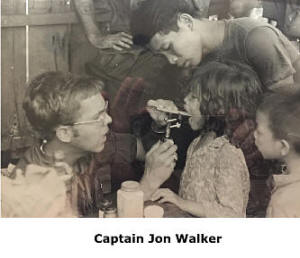 For some reason,
neither Rick nor I were sleeping well that night. Around 2:30 AM, we heard
an explosion followed by M16 fire coming from what seemed like the northeast
perimeter of the base. We were immediately up, and it appeared all hell
broke loose. Some of my medics came down to the Aid Station. I was standing
near the opening, where the hooch abutted the Aid Station when an explosion
right outside knocked me across the Aid Station and onto the floor. We
assumed it was a grenade and that another one may land in our hole. That
didn’t happen, so I eventually stood up and shined my flashlight into the
hooch, fully expecting to be shot. What I discovered was that a Rifle
Propelled Granade (RPG) had landed at the other end of the hooch, and the
hooch directed the concussion into the Aid Station where I was standing.
Around that same time, we began hearing calls for “Medic!”
For some reason,
neither Rick nor I were sleeping well that night. Around 2:30 AM, we heard
an explosion followed by M16 fire coming from what seemed like the northeast
perimeter of the base. We were immediately up, and it appeared all hell
broke loose. Some of my medics came down to the Aid Station. I was standing
near the opening, where the hooch abutted the Aid Station when an explosion
right outside knocked me across the Aid Station and onto the floor. We
assumed it was a grenade and that another one may land in our hole. That
didn’t happen, so I eventually stood up and shined my flashlight into the
hooch, fully expecting to be shot. What I discovered was that a Rifle
Propelled Granade (RPG) had landed at the other end of the hooch, and the
hooch directed the concussion into the Aid Station where I was standing.
Around that same time, we began hearing calls for “Medic!”
I was ready to
go out when cool-headed Rick Fortune told me to stay put. I was the only
doctor on the base, and he and the other medics needed to know where I would
be. Shortly after that, I started receiving the wounded. It was chaos, the
ground was muddy, and it was still raining. We were next to a mortar pit, so
as they unwrapped the plastic from the mortar ammo, they would throw it over
to us for use as covers. I quickly assessed each soldier and tried to
determine the extent of the injuries and what action to take. My supplies
were meager.
I had Kling wrap, Ace bandages, gauze, Vaseline gauze,
sterile saline, and curettes of morphine (imagine a small tube of toothpaste
with a needle attached. You put the needle in the patient then squeeze the
morphine out of the tube). Specific injuries remain in my memory: an SGT who
shot in the thigh with an AK-47. The entry wound was small, but the exit
wound in the back of his leg was massive. I packed it with gauze and wrapped
it tightly with an ace wrap, which seemed to control the bleeding. I
remember a soldier with a pneumothorax (collapsed lung), and all I had to
plug the wounds with was Vaseline gauze (maybe LT Chase?). There was another
soldier with multiple shrapnel wounds on his chest and face who was awake
and looked at me when I spoke but didn’t respond.
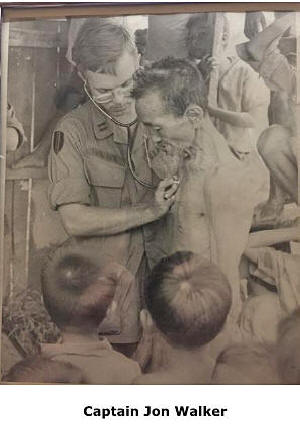 Additionally there was
a soldier who didn’t look too bad initially but had a massive scalp wound on
the back of his head. I cleaned it with saline, then replaced the skin flap,
and wrapped his head with Kling holding the flap in place. There were
numerous broken bones and lacerations. We splinted what we could and dressed
the wounds but didn’t have the time or the supplies to suture. All told we
had 33 wounded soldiers for about three to four hours. We had no air support
because of the weather and no way to evacuate anyone. When the weather
cleared a little around 6 AM, the first chopper in was a Huey Medevac. I
tried to evacuate the most serious on it and was able to get nine men (as I
recall) out. Shortly after that, I got word a Chinook had just delivered
artillery ammo to the other side of the base and was coming over to evacuate
the wounded. They settled down just outside the perimeter, and I was able to
get everyone else on board. So within five minutes, we went from 33 wounded
to none. As I gradually came back to reality, I didn’t fully comprehend what
had just happened. I was relieved, but other emotions just swirled. I still
remember blood just running in rivulets across the ground.
Additionally there was
a soldier who didn’t look too bad initially but had a massive scalp wound on
the back of his head. I cleaned it with saline, then replaced the skin flap,
and wrapped his head with Kling holding the flap in place. There were
numerous broken bones and lacerations. We splinted what we could and dressed
the wounds but didn’t have the time or the supplies to suture. All told we
had 33 wounded soldiers for about three to four hours. We had no air support
because of the weather and no way to evacuate anyone. When the weather
cleared a little around 6 AM, the first chopper in was a Huey Medevac. I
tried to evacuate the most serious on it and was able to get nine men (as I
recall) out. Shortly after that, I got word a Chinook had just delivered
artillery ammo to the other side of the base and was coming over to evacuate
the wounded. They settled down just outside the perimeter, and I was able to
get everyone else on board. So within five minutes, we went from 33 wounded
to none. As I gradually came back to reality, I didn’t fully comprehend what
had just happened. I was relieved, but other emotions just swirled. I still
remember blood just running in rivulets across the ground.
I eventually
went for a walk with Rick Fortune and viewed at least 28 enemy bodies
outside the perimeter, many of them just blown apart. We thought we heard an
AK-47 near the Aid Station at one point and, indeed, found spent AK shells
on the ground. I assume the shooter was on the roof of the Aid Station. Was
he the one who was shot?
I later found out that Rick Fortune went out
without his “steel pot” to identify him as American. The Sgt Major (whose
name I can’t recall but would like to know) told me he had Rick in his
sights but recognized him at the last minute and didn’t shoot. (Historian's
note: The Sergeant Major was CSM Bell.)
We didn’t lose any GIs at the
base, and I subsequently learned all survived. I’m especially pleased to
know that. I eventually got a Bronze Star with a V, which was certainly a
novelty at my next assignment in the Out-Patient Clinic at Fort Gordon, GA.
And that’s my story. I haven’t been able to find my name anywhere in the
records but occasionally will look. I was the only doctor on FSB David on
that infamous day. I left the Army in the fall of 1971, specialized in
Urology, and am now retired after practicing in Lancaster, PA, for over 30
years.
TOM GARNELLA
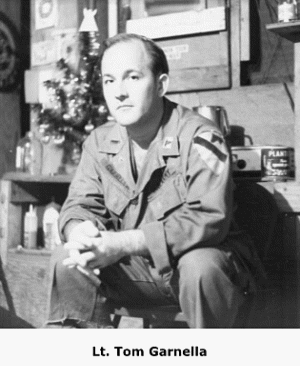 Historian's Note:
1LT Tom Garnella was the Medical Operations Assistant at B Co., 15th Med BN
02/70-02/71. Tom also gets the credit for inviting Joel and Dorothy to the
Branson Reunion, thereby getting work on this story started.
Historian's Note:
1LT Tom Garnella was the Medical Operations Assistant at B Co., 15th Med BN
02/70-02/71. Tom also gets the credit for inviting Joel and Dorothy to the
Branson Reunion, thereby getting work on this story started.
When
Joel got to FSB Buttons, he and 1LT Tom Garnella both got the surprise of
their lives! Joel had been an OCS TAC Officer at Fort Benning, GA, and Tom
was one of his officer candidates! Here is what Tom had to say:
“You
are correct that when Chase was brought into the FSB Buttons aid station, it
was I who looked down and immediately recognized him. Like you asked, what
are the odds of my Ft. Benning TAC Officer coming into the aid station to
which I was assigned? Unbelievable!!! Who could ever forget their Infantry
OCS Tac Officer who decided I should be commissioned as a 3506 MOS, Field
Medical Assistant. Concerning Chase, my role was basically to assure Chase
that he would live and that Doc Lundquist and others would take care of him
as we prepared to send him to the 24th Evac. Doc Lundquist allowed me to
accompany Chase to the 24th, where I stayed by Chase's side for two days
before having to return to FSB Buttons“.
A little extra irony was
that Joel had recommended that Tom go into the Medical Service Corps instead
of the Infantry.
Tom mentioned his gratitude to his friend, CPT Dean
Stoller, MC, with HSC 15th Med BN for helping him to connect with Joel Chase
45 years after his tour in Vietnam.
JON LUNDQUIST
Historian's Note: CPT Jon Lundquist, MC, was the Commanding Officer of B Co.
and the physician that treated Joel. He does not explicitly remember
treating Joel because of all the other seriously wounded that came into his
facility.
RICHARD SCHRODER
Historian's Note: SP5
Richard Schroder, Clinical Specialist, 12/69-12/70 recalls very well the day
that a Chinook brought in a load of wounded to FSB Buttons. Here is what he
said.
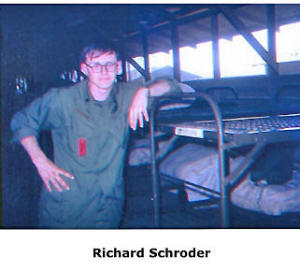 “I do remember very well a Chinook that brought some wounded to
Buttons, and I believe that was the only time a Chinook landed on our Huey
pad while I was with B Company. We had gotten the word that the Chinook was
coming to the Chinook pad with wounded, so we sent our ambulances and medic
up to the Chinook pad to get the wounded. Another SSG 91C and I stayed
behind to get the treatment bunker ready to receive the wounded and to alert
the Docs. I remember the surprised look on our faces when we heard the
Chinook and realized it was landing on our pad. Several of our big GP tents
were acting like giant bellows, but none came down; however, our 50-gallon
trash containers got caught in the downward and were blown all over the
place. We told our clerk to recall our medics and ambulances and to notify
the docs and any off duty personnel as we figured we were going to need help
once the chopper landed. Once the Chinook landed, we started to offload the
wounded by way of the rear ramp (I still can remember the heat coming from
the engines).“
“I do remember very well a Chinook that brought some wounded to
Buttons, and I believe that was the only time a Chinook landed on our Huey
pad while I was with B Company. We had gotten the word that the Chinook was
coming to the Chinook pad with wounded, so we sent our ambulances and medic
up to the Chinook pad to get the wounded. Another SSG 91C and I stayed
behind to get the treatment bunker ready to receive the wounded and to alert
the Docs. I remember the surprised look on our faces when we heard the
Chinook and realized it was landing on our pad. Several of our big GP tents
were acting like giant bellows, but none came down; however, our 50-gallon
trash containers got caught in the downward and were blown all over the
place. We told our clerk to recall our medics and ambulances and to notify
the docs and any off duty personnel as we figured we were going to need help
once the chopper landed. Once the Chinook landed, we started to offload the
wounded by way of the rear ramp (I still can remember the heat coming from
the engines).“
CHINOOK CREW
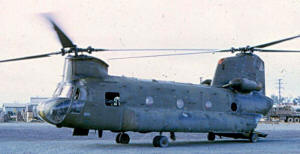 Historian's Note: Also, heroes
that day were the crew of that Chinook who, after making an emergency
delivery of ammunition, hauled 24 wounded to FSB Buttons. Presumably, that
Chinook would have been from the 228th Assault Support Helicopter BN. An
attempt was made to identify the pilot and crew by postings on several
Facebook pages, including the Vietnam 1st Cavalry Facebook page with some
responses received. Bill Lee, who was Operations SGT with Charlie Co., 228th
ASHB, suggested it was a Chinook pilot with that unit named Bob Barr
(nickname “Cowboy Bob”) who many times did offer to transport wounded under
similar situations. We were not able to find his name on any of the 228th
ASHB rosters, VHPA rosters, or 1st Cavalry Division Assn membership rosters.
I was notified by Bob Braa that he was a Chinook Pilot whose nickname was
“Cowboy Bob,” and that his crew was on standby at FSB David that day, but a
different crew made the pickup of the wounded. Unfortunately, no additional
information was found on the identity of that crew. If anyone reading this
knows, please contact
historian@15thmedbnassociation.org . I
understand it was not uncommon for Chinook crews to transport wounded.
Historian's Note: Also, heroes
that day were the crew of that Chinook who, after making an emergency
delivery of ammunition, hauled 24 wounded to FSB Buttons. Presumably, that
Chinook would have been from the 228th Assault Support Helicopter BN. An
attempt was made to identify the pilot and crew by postings on several
Facebook pages, including the Vietnam 1st Cavalry Facebook page with some
responses received. Bill Lee, who was Operations SGT with Charlie Co., 228th
ASHB, suggested it was a Chinook pilot with that unit named Bob Barr
(nickname “Cowboy Bob”) who many times did offer to transport wounded under
similar situations. We were not able to find his name on any of the 228th
ASHB rosters, VHPA rosters, or 1st Cavalry Division Assn membership rosters.
I was notified by Bob Braa that he was a Chinook Pilot whose nickname was
“Cowboy Bob,” and that his crew was on standby at FSB David that day, but a
different crew made the pickup of the wounded. Unfortunately, no additional
information was found on the identity of that crew. If anyone reading this
knows, please contact
historian@15thmedbnassociation.org . I
understand it was not uncommon for Chinook crews to transport wounded.
ADDITIONAL COMMENTS BY JOEL CHASE
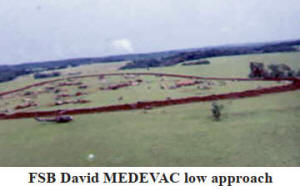 Part of the story
about the defense of David that has received “little ink” is the heroics of
Mike Crutcher during the battle. Mike, the CO of the Recon Co, was all over
the place, and at one point, Bill Vowell CO of D Co realized the enemy was
in a few of our bunkers, which was a dangerous development. Bill asked the
adjoining bunker commander if he could move to retake the bunkers, which
were threatening the entire firebase. The response was he "couldn't move."
Mike Crutcher was aware of the conversation and communication and sprang
into action with a small volunteer posse and retook the bunkers from the
enemy which, was a critical move in securing the perimeter. Mike was awarded
the Silver Star for his heroics and eventually retired from the Army as a
Colonel. What a fine and brave young officer!
Part of the story
about the defense of David that has received “little ink” is the heroics of
Mike Crutcher during the battle. Mike, the CO of the Recon Co, was all over
the place, and at one point, Bill Vowell CO of D Co realized the enemy was
in a few of our bunkers, which was a dangerous development. Bill asked the
adjoining bunker commander if he could move to retake the bunkers, which
were threatening the entire firebase. The response was he "couldn't move."
Mike Crutcher was aware of the conversation and communication and sprang
into action with a small volunteer posse and retook the bunkers from the
enemy which, was a critical move in securing the perimeter. Mike was awarded
the Silver Star for his heroics and eventually retired from the Army as a
Colonel. What a fine and brave young officer!
I had learned from the
enemy not to present the expected. They changed things to make a probe look
like an attack and make an attack appear to be just a probe. To counter
that, I had our guys string 25 tripwires and flares in front of each bunker.
They were crisscrossed side to side and front to back - some high and some
low in the grass. Then we moved the claymores back to the berm and
sandbagged them after dark so the NVA didn't know where they were and
couldn't play with them. Note: The NVA were watching us from nearby hills,
so we needed to “play cute” showing our hand during the day and moving
positions after dark. That may not seem important, but as every infantryman
will tell you - take advantage of all available resources.
The NVA
that attempted to overtake David was a combination of their elite sappers
and Infantry. The estimated number was a reinforced company, but I'm not
sure how that relates to personnel in their configuration. The first line of
attackers were sappers who would open avenues through concertina wire and
trip flares of approach for the attackers that followed. They frequently
stripped off their clothing to minimize getting snagged in barbed wire.
Sometimes they wove mats of grass that they put on their backs as
camouflage. When they encountered our concertina wire, they would slither
through it like a snake and continue forward after placing satchel charges
in the wire to blow holes for their comrades when the attack began. Some
sappers would take long blades of grass and "feel" their way through trip
flare wires. If the grass bent, they would find the wire and follow it to
the source, hoping to disarm the trip. Sometimes they guessed wrong and
simply found the anchor to the trip, but they would retrace their route and
disable the tripwire at the other end by pinning it. All this took time -
lots of it. Sappers would typically begin their crawl to the objective just
after sunset and spend as much as three hours weaving their way through
barbed wire and trip flare wires. The weather on 14 June played to their
favor as dense fog reduced visibility earlier than usual, giving them an
early rally point. I had seen demonstrations of how sappers could silently
infiltrate a position that quite frankly scared me. They were good - VERY
good.
To counter the capabilities of the sappers, we installed 25
trip flares in front of the four bunkers in my sector. It looked like the
inside of two pianos going at 90 degrees in different directions. Usually,
our claymore mines were placed just inside the wire. (Claymore mines had
steel balls embedded in a plastic backing and two pounds of C-4 explosive to
propel the balls toward the enemy). Knowing we were being watched or mapped,
we put out the claymores during the day and then moved them back to the berm
to use their impact better and eliminate possible NVA tampering. Yep. The
NVA would take the reflective engineering tape off the back of a claymore,
turn the claymore around and replace the tape as nothing happened.
The Cav beat the NVA best at their own game in defending FSB David. The guys
who waged that battle were mostly enlisted men who did an extraordinary job
of holding their ground and repulsing a large enemy force. I believe their
story deserves retelling and retelling.
To the Medevac crews that
rescued me not only on 14 June 70 but throughout my time in Vietnam: You
were calm on the radio and taught me to do the same, which my guys observed
and served to maintain some sort of organization even under fire. You guys
were the greatest, and I have the highest admiration for you all!
I
always looked forward to getting my guys on birds going out, but inbound
birds meant danger ahead and the unknown. We always knew you were there when
we needed you, which was important.
When you get involved with “bad
guys” and are in desperate need of medical help, the guys on the ground
always felt the choppers with the red cross would somehow come to our
rescue. You made us braver than we were - you guys are my heroes.
To
CPT Jon Lundquist, B Co., 15th Medical Battalion Commander, and CPT Jon
Walker, 1/5 BN Surgeon and their medics and other medical personnel, without
whose skill, determination, and compassion, I would not be here today, I am
forever in your debt!
God Bless you all, and thank you!
Joel
Historian's Note: In closing, Joel has these two stories that have
nothing to do with FSB David but are two of his favorite stories from
Vietnam.
“Our battalion got a new commander, and we were at an
established FSB near the Cambodian border. Our new "leader" decided the
place needed some grooming and ordered all cigarette butts and matches to be
policed by the troops guarding the perimeter. Inspections would be
performed, and if violations were discovered, the personnel at the offending
bunker would get no beer or soda. So I asked my guys to be perfectionists
and deliver their trash to me. After dark, I took a large pail of matches
and butts up to the TOC and scattered them all over the place. I guess
somebody got the message because the inspections stopped. If our fearless
leader had wanted to do something healthy for his troops, he could have
requisitioned a case of rat traps to reduce the infestation of vermin in the
bunkers around the perimeter where we slept. The life of the grunt was
considerably different than other MOS's, and quite frankly, I preferred
pounding the brush to rear echelon duty. ”
 “After a few weeks at
24th Evac after being wounded, I was well enough to transport to Japan. I
was ambulatory and picked up my war trophy SKS rifle in preparation for
transport to the airport. A rickety old Air Force blue bus arrived, and a
bunch of walking wounded boarded, and in retrospect, our transport probably
had no springs. It immediately became apparent the driver was a masochistic
bastard because he hit every curb, pothole, and bump on the way to the
airport. He was a real pro at accelerating and decelerating. There were lots
of moans and groans from the wounded passengers, which simply seemed to give
the driver greater pleasure from abusing his passengers. When we arrived at
the airport, we found our flight canceled due to weather, so we pulled a “Uey”
and returned to the 24th Evac Hospital with more bumps and bruises. Same routine the
next day with more passenger agony, which pissed me off, so I fixed the
bayonet on my SKS and began an advance toward the driver. He saw me coming
in his rearview mirror, and I gently pushed the point of the bayonet on the
back of his neck. I said: "OK, asshole, if you hit one more curb, pothole,
or bump, you'll be looking at the point of this thing through a buttonhole
in the front of your shirt - GOT IT?!" It turned out that kid was an
excellent bus driver, and I got a rousing cheer from the other passengers.”
“After a few weeks at
24th Evac after being wounded, I was well enough to transport to Japan. I
was ambulatory and picked up my war trophy SKS rifle in preparation for
transport to the airport. A rickety old Air Force blue bus arrived, and a
bunch of walking wounded boarded, and in retrospect, our transport probably
had no springs. It immediately became apparent the driver was a masochistic
bastard because he hit every curb, pothole, and bump on the way to the
airport. He was a real pro at accelerating and decelerating. There were lots
of moans and groans from the wounded passengers, which simply seemed to give
the driver greater pleasure from abusing his passengers. When we arrived at
the airport, we found our flight canceled due to weather, so we pulled a “Uey”
and returned to the 24th Evac Hospital with more bumps and bruises. Same routine the
next day with more passenger agony, which pissed me off, so I fixed the
bayonet on my SKS and began an advance toward the driver. He saw me coming
in his rearview mirror, and I gently pushed the point of the bayonet on the
back of his neck. I said: "OK, asshole, if you hit one more curb, pothole,
or bump, you'll be looking at the point of this thing through a buttonhole
in the front of your shirt - GOT IT?!" It turned out that kid was an
excellent bus driver, and I got a rousing cheer from the other passengers.”
Acknowledgment
The authors extend their appreciation to Mike
Bodnar, former Medevac Medic (1/70-7/70) and Editor of the 15th Medical BN
Column in SABER, the 1st Cavalry Division Association's bimonthly newsletter
for research and writing that he has done on the subject of the defense of
FSB David on 14 June 1970. Readers may find his columns in the
November-December 2019 and the January-February 2020 issues of interest.
Go
to the Index, then 2019 Nov-Dec and 2020 Jan-Feb.
Historian's Note: This story is “Mission 20” in Phil Marshall’s book;
Helicopter Rescues Vietnam, Volume XI. This book is the 11th 15th Medical
Battalion Medevac mission included in Phil’s 13 books. Helicopter Rescues
Vietnam, Volume XI, and Phil's other 12 books as well, may be purchased by
going to
Amazon.com.”
If you would like a copy signed by the author with a written dedication, any
of Phil’s 13 books may be purchased directly from him for $20.00 each, which
includes sales tax, postage, and handling. Send cash or check (payable to
Phil Marshall) for $20.00 per book with instructions on what book(s) you
want to order and where to send the book(s) and what, if anything, you would
like in the dedication. His address is 1063 Cardinal Dr., Enon, OH 45323,
the phone is 937-371-3643, and his e-mail is
dmz.dustoff@yahoo.com . You may
also use PayPal. Phone or e-mail Phil with any questions.
[ Return To Index ]